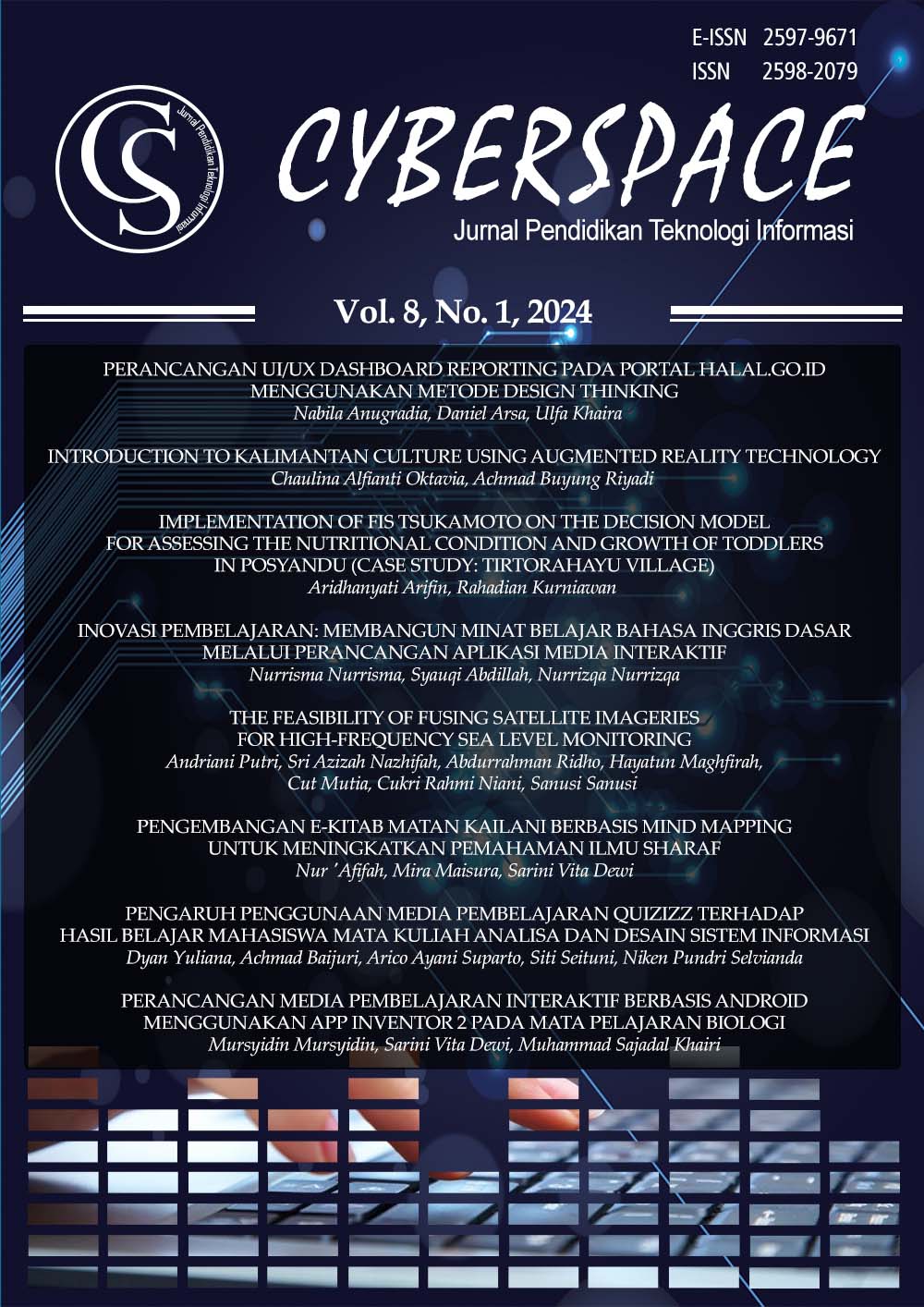PENGARUH PENGGUNAAN MEDIA PEMBELAJARAN QUIZIZZ TERHADAP HASIL BELAJAR MAHASISWA MATA KULIAH ANALISA DAN DESAIN SISTEM INFORMASI
DOI:
https://doi.org/10.22373/cj.v8i1.23630Kata Kunci:
Learning Media, Quizizz, Learning Outcomes, ANDESISFOAbstrak
The development of Information and Communication Technology is currently growing very rapidly, this is proven by the emergence of sophisticated technological equipment that has changed human lifestyles today. As educators, of course we must be able to adapt the way we educate them according to the current lifestyle in the digital era in order to prepare them to face challenges in the future. Educators are required to make innovations in the learning process. To support the needs needed to implement active learning in the classroom, there needs to be media that can support the implementation of learning optimally to stimulate effective communication skills through active learning that integrates information and communication technology. One of the learning media that is widely used today is Quizizz, which is an educational game application that can support the learning process significantly for measuring or assessing the learning process. Presenting questions in game form can attract students' interest, so that they will be more enthusiastic in working on the questions given. This research uses a quantitative research approach with a pre-experimental design type with a one group pretest posttest design research form. Decision making through hypothesis testing using the SPSS version 29 application. The hypothesis testing technique uses the paired sample t-test and simple linear regression test. The results obtained from the paired sample t-test in SPSS version 29 are known as the sig value. (2-tailed) of 0.001. In accordance with the basis for decision making in the paired sample T-test that the sig. (2-tailed) < 0.05 or 0.001 < 0.05, then H0 is rejected and Ha is accepted, meaning that there is a significant difference between the pretest and posttest results with an influence level of 0.144 or 14.4% so it can be concluded that there is an influence of use Quizizz learning media on the learning outcomes of fifth semester students in the Information Systems Analysis and Design course at STKIP PGRI Situbondo.Referensi
Nunu Mahnun, “Peranan Media Pembelajaran Dalam Meningkatkan Minat Belajar Mahasiswa,” J. Komun. Pendidik., vol. 2, no. 2, p. 103, 2012, doi: 10.32585/jkp.v2i2.113.
Yudiantara, “Pengembangan Media Pembelajaran Berbasis Multimedia Pada Mata Kuliah Kompetensi Pembelajaran Pokok Materi Keterampilan Dasar Mengajar,” J. Pendidik. Tek. Sipil, vol. 8, no. 1, pp. 24–30, 2015.
R. Sumiharsono and H. Hasanah, Media Pembelajaran: Buku Bacaan Wajib Dosen, Guru, dan Calon Pendidik. Jember: CV. Pustaka Abadi, 2018.
A. E. Hapsari, “Penerapan Model Pembelajaran Kooperatif Tipe Numbered Heads Together Berbantuan Media Interaktif untuk Meningkatkan Aktivitas dan Prestasi Belajar Siswa,” Sch. J. Pendidik. dan Kebud., vol. 7, no. 1, pp. 1–9, 2017.
D. Iga Luhsasi and C. Lita Permatasari, “Trade Game Akuntasi Untuk Siswa Sekolah Menengah Atas,” Sch. J. Pendidik. dan Kebud., vol. 10, no. 1, pp. 51–59, 2020.
D. S. Sitorus, Siswandari, and Kristiani, “The Effectiveness of Accounting E-Module Integrated with Character Value to Improve Students’ Learning Outcomes and Honesty,” Cakrawala Pendidik., vol. 38, no. 1, pp. 120–129, 2019.
S. P. Anggia and T. Musfiroh, “Pengembangan Media Game Digital Edukatif,” J. LingTera, vol. 1, no. 2, pp. 123–135, 2014.
S. De Freitas, “Learning in Immersive worlds A review of game-based learning Prepared for the JISC e-Learning Programme.” [Online]. Available: http://www.jisc.ac.uk/uploaded_documents/Summary_report
R. Winatha and K. M. D. Setiawan, “Pengaruh Game-Based Learning Terhadap Motivasi dan Prestasi Belajar The Effect Of Game-Based Learning Towards The Learning Motivation and Achievement,” Sch. J. Pendidik. dan Kebud., vol. 10, no. 3, pp. 198–206, 2020.
E. Nurhayati, “Meningkatkan Keaktifan Siswa Dalam Pembelajaran Daring Melalui Media Game Edukasi Quiziz pada Masa Pencegahan Penyebaran Covid-19,” J. Pedagog., vol. 7, no. 3, p. 145, 2020, doi: https://doi.org/10.33394/jp.v7i3.2645.
Sudijono, “Faktor-Faktor Yang Mempengaruhi Hasil Belajar Siswa Pada Pembelajaran Praktik Kelistrikan Otomotif Smk Di Kota Yogyakarta,” J. Pendidik. Vokasi, vol. 6, no. 1, p. 111, 2012, doi: 10.21831/jpv.v6i1.8118.
Sugiyono, “Halus Pada Anak Kelompok A Di TK Hidayatullah Lidah Kulon Surabaya,” pp. 3–6, 2015.
Sugiyono, “Pengaruh Harga Jual Kaca Patri Jenis Silver Terhadap Nilai Penjualan Pada Cv. Karunia Kaca Palembang Tahun 2004-2015,” J. Ecoment Glob., vol. 2, no. 2, p. 49, 2014, doi: 10.35908/jeg.v2i2.251.
S. Arikunto, Prosedur Penelitian Suatu Pendekatan Praktik. Jakarta: Rineka Cipta, 2010.
Sundayana, “Metode Penelitian Metode Penelitian,” vol. 2, pp. 22–34, 2014.
Unduhan
Diterbitkan
Terbitan
Bagian
Lisensi
Authors who publish with Cyberspace Journal agree to the following terms:
- Authors retain copyright and grant the journal right of first publication with the work simultaneously licensed under a Creative Commons Attribution License that allows others to share the work with an acknowledgement of the work's authorship and initial publication in this journal.
- Authors are able to enter into separate, additional contractual arrangements for the non-exclusive distribution of the journal's published version of the work (e.g., post it to an institutional repository or publish it in a book), with an acknowledgement of its initial publication in this journal.
- Authors are permitted and encouraged to post their work online (e.g., in institutional repositories or on their website) prior to and during the submission process, as it can lead to productive exchanges, as well as earlier and greater citation of published work (See The Effect of Open Access).



















